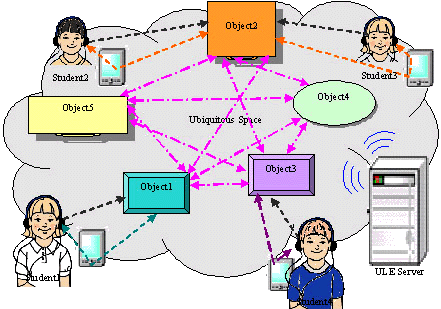e-Learning Ecologies MOOC’s Updates
Ubiquitous Learning through MOOCs
Ubiquitous learning has its roots in 'Ubiquitous Computing' - a term coined by Mark Weiser of Xerox in early 1980s [1]. Weiser imagined how computers could be seamlessly integrated into the physical world using computing. With personal computing technologies leapfrogging, we are now at a juncture where every student is seamlessly embedded / connected to multiple devices, presenting ever-before learning opportunities and potential. Ubiquitous Learning refers to those learning technologies that enable learning - anywhere, anytime and anyone.
Massive Open Online Courses (MOOCs) fit the description of Ubiquitous Learning, quite naturally. The Massive Open Online Courses or MOOCs have their origins in 2008 in Canada with a course called ‘Connectivism and Connected Knowledge’ by Stephen Downes and George Siemens [2]. In their current form, a MOOC is a course designed for large numbers of participants, with / without definitive start or end times and are open to access for anyone with an internet connection [3] – thus rendering it ‘anytime’ and ‘anywhere’ as per ubiquitous learning definitions. Further, when we deconstruct the acronym – MOOC is “massive” because it can enroll hundreds of thousands of learners in one go, - where students can interact with one another, it is “open” as anyone with access to the internet connection can enroll and most courses are free and it is “online” –on the world wide web [4].
MOOCs and e-affordances
Bill Cope and Mary Kalantiz, the instructors of this course outline in a paper titled “Ubiquitous Learning: An Agenda for Educational Transformation” the 7 moves characteristic to ubiquitous learning and how technology has made these possible [5]. Here is how the MOOCs platform matches against those discussed in Week 1 of the course.
Characteristics of Ubiquitous Learning & How MOOCs attains it
Here's a video on how this platform is aiding ubiquitous learning:
Collapsing of Space and Time
Most MOOCs courses no longer have a definitive start and end time. Learners are free to explore resources at their convenience and time. MOOCs does not require learners to be in a restrictive learning environment – learners are free to learn from where it is convenient for them, It is really anytime, anywhere – where you have an internet connection and a willingness to learn.
Interpersonal and one to many
MOOCs is really a borderless classroom set up where there are opportunities to interact with peers and instructors at the same time. It allows for commenting simultaneously as well as interacting with one/many people at the same time without having to wait in a queue after you shoot your hand up in a physical classroom.
Transparency and Surveillance
All MOOC learners leave something akin to a ‘learning trail’ behind them. Their course behaviors, outcomes and habits are visible and open to surveillance by the instructors. Big Data analytics are said to be able to predict the course outcomes of a student based on a profile generated from his previous / historic course interactions. MOOCs thus brings in immense transparency and opportunity for surveillance the way ubiquitous learning scenarios demand.
Fosters persistence, inquisitiveness searching
MOOCs is said to attract two kinds of learners with varying needs – functional and life-long learners [6]. Studies on those who complete MOOC courses has shown that those with higher self efficacies, those with a nature to learn new things and are curious in nature are the ones that survive MOOC pressures [7]
References
[1] Jones, V., & Jo, J. H. (2004, December). Ubiquitous learning environment: An adaptive teaching system using ubiquitous technology. In Beyond the comfort zone: Proceedings of the 21st ASCILITE Conference (Vol. 468, p. 474). Chicago
[2] B. Scardilli, 'MOOCs: Classes for the Masses', Information Today, no. 308, 2013.
[3] Openuped, 'Definition Massive Open Online Courses (MOOCs)', 2015. [Online].
[4] J. Meister, 'How MOOCs Will Revolutionize Corporate Learning And Development', Forbes, 2013.
[5] Cope, B., & Kalantzis, M. (2009). Ubiquitous learning: An agenda for educational transformation. Ubiquitous learning, 3-14.
[6] Kaveri, A., Gunasekar, S., Gupta, D., & Pratap, M. (2015, October). Decoding the Indian MOOC learner. In MOOCs, Innovation and Technology in Education (MITE), 2015 IEEE 3rd International Conference on (pp. 182-187). IEEE.
[7] Kaveri, A., Gunasekar, S., Gupta, D., & Pratap, M. (2016, December). Decoding Engagement in MOOCs: An Indian Learner Perspective. In Technology for Education (T4E), 2016 IEEE Eighth International Conference on (pp. 100-105). IEEE.



Fantastic post that i enjoyed reading immensely as I do strongly believe that those who believe in lifelong learning welcome the idea of ubiquitous learning. On the other hand I like the concepts behind MOOCs but never made the link to ubiquitous learning. Thanks for this.
Unfortunately, Ubiquitous Learning is still largely a pie-in-the-sky idea. All it means is that learning is possible all the time, not that it is in fact common or easy. Marc Prensky coined the term Digital Natives some years ago in a famous essay that excoriated the vast majority of teachers as behind-the-times Digital Immigrants, but my experience -- and I fit into the Digital Immigrant category by age and experience -- reveals that we still have a long way to go. My working class college freshman, true, love technology, but this really means having the latest phone or tablet and using one or two of the most popular apps such as messaging or Instagram. They are laggards when it comes to using it for their education -- except to find quick and easy quotes to slip into their writing or, worse, writing they can plagiarize. Ubiquitous Learning won't happen as a common phenomenon until we have Ubiquitous Tech Training for everyone.
Thank you Alan - encouraging to know it made sense :)
A very concise article on the history of MOOCs with plenty of detailed references and good use of graphics and video clips.